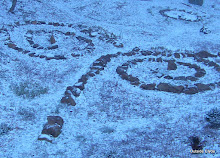There was a time when that would be nothing unusual. Then the tiny little Woolly Adelgid came and killed entire groves of giant one hundred foot tall hemlock trees.
When I arrived in 2007 the infestation was at its peak. The massive trees were sick and dying dozens at a time. We lost two mature groves on this small patch of land. Five trees close to the resident gardeners house were treated with the neonicotinoid imidacloprid and saved.
The rest died and have been slowly crashing to the ground. The forest is a shambles where the hemlocks once stood. You just know that makes my maintenance gardener self crazy.
In the last two years I have noticed a change. Hemlock trees with even one surviving branch were looking perky and greener. That one remaining branch was starting to grow. The tell tale white woolly of the adelgid was gone. The smallest trees were the ones that had been spared. A few escaped mostly intact. Now they are growing again.
This is likely the result of the release of the adelgid predator beetle becoming established in the environment. I have read that there is a fifteen to twenty year supply of hemlock seeds in the soil. If the predator control worked, the hemlocks would come back in time. Without really looking I spotted one tiny hemlock seedling amid all the destruction.
I had not wandered into the forest to look at hemlock trees. On a grey and foggy day in the barren time, that long lost evergreen couldn't be missed.
I wandered into the forest looking for rocks, white rocks in particular that I think are a quartzite. Someone I know is getting a box of rocks for Christmas.
The bad news is there are plenty of the white quartzite rocks down there in the forest. I have no idea what, but I see another art project in my future.
It is written in the stone.
The earth told me it will be just fine. I have lived through eons of destruction. The question is, does mankind want to stick around for the ride?
Life comes and goes in many forms. Life is permanent. The form is not.
Thursday, December 17, 2015
Subscribe to:
Post Comments (Atom)













8 comments:
Very encouraging news about the Hemlocks...
You have brightened my day!
Matt
Love those Hemlocks. Planted them as a screen while in N.C. Now they are huge. Didn't recognize the place till got to the church. I'm glad they are coming back.
Regarding your pic #7 of the old chimney....I went back and looked at the same shot taken back in late October with intense colors .....which I saved to my Gallery. What a stark difference. Maybe you could post them side by side for your other Blog buddies to see the seasonal changes.
How exciting that some of the Hemlocks have survived and hopefully will thrive.
I envy your gift recipient.
What an interesting thought "Life is permanent. The form is not." I think this can apply to all.
It is good news for the hemlocks Matt. They grow fast. In ten years they could be a big presence again.
Lola hemlocks were commonly used for screening and hedges. Now that may be possible again which is good since a new fatal disease is attacking the other common choice Leyland Cypress.
That reminds me Dana. The sister-in-law wanted a seasonal series of the chimney.
Lisa the baby hemlocks biggest threat now is getting crushed by their falling elders. I actually set aside a white quartzite rock for you during the Asheville Fling and of course forgot to tell you. Deep thoughts from the Deep Forest.
Yes, Christopher.....the 4 seasons of the old chimney would be a grouping.....suitable for framing! Can't wait to see it!
I too would like to see the old chimney in a 4 seasons grouping. Love the old chimney.
I loved hemlock in the woods of upstate New York where I grew up. They do not grow here in the Virginia coastal plain, and am happy to learn that they grow in the mountains of Carolinas and are coming back after being decimated. Beautiful calming evergreen.
Ray
Post a Comment